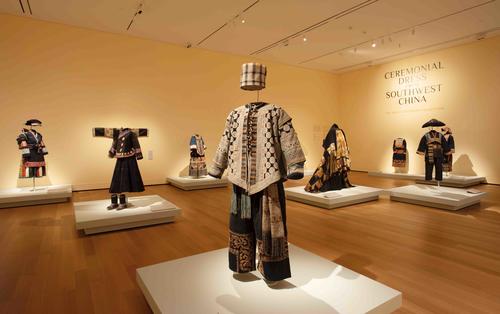
A collection of ceremonial clothing from communities in southwestern China is on view in the Yale University Art Gallery until Jan. 5, 2020. The exhibition, titled “Ceremonial Dress from Southwest China: The Ann B. Goodman Collection,” features clothing made by women of ethnic minority groups living in Guizhou, Hunan, Sichuan, Yunnan and other provinces in the 19th and 20th centuries.
The exhibited works are drawn from a collection gifted to the YUAG by Ann B. Goodman in 2015. The complete collection contains more than 600 individual items, some of which form full or partial outfits. According to Denise Patry Leidy — the YUAG’s Ruth and Bruce Dayton curator of Asian art and co-curator of the exhibition — the pieces on display were chosen based on their aesthetic value, condition and the range of cultures and styles they represent.
“One of the curatorial choices here was to show the ensembles, as they show a very sophisticated way of thinking about design and space,” Leidy said.
The exhibition showcases the visual imagination, artistic skills and technical knowledge of the women who produced the clothing. Co-curator Ruth Barnes, the Thomas Jaffe curator of Indo-Pacific art, described the “laborious” production process of a man’s ceremonial ensemble. Made by a young woman for her fiance, the process involves using indigo dye and stitching patterns of “incredible detail” across multiple layers. Both curators emphasized the skill and patience involved in the creation of the pieces exhibited.
Barnes explained that the clothing exhibited was worn during harvest festivals and special life cycle occasions like weddings and funerals. The pieces on view are largely handmade from start to finish, from the growing and harvesting of the cotton to the weaving, dyeing and embellishing of the clothing.
The curators noted that a sufficient body of research to explain the meanings of the clothings’ various patterns does not yet exist. The curators believe that the patterns drew from long-standing cultural traditions.
Barnes said that the exhibition’s collection of baby carriers is a “good example of the different techniques and stylistic elements found within these communities.”
The clothing of the different ethnic groups are distinguished by subtle stylistic differences and show a “give and take between cultures,” according to Leidy. Some of the communities had lived in proximity to the Han Chinese — the majority ethnic group in China — for a long time, a phenomenon that is reflected in the intermingling of stylistic influences in the clothing. The exhibition includes a bridal necklace from the Yi ethnic group inscribed with good wishes in Mandarin Chinese characters and auspicious symbols from Han culture and a Yao jacket featuring a crossover design to the right, which is a distinctly Han Chinese tailoring style. Leidy noted that these artistic combinations showcase a “nice balance” of “borrowing from a broader culture but still maintaining a tradition.”
The exhibition also features a collection of ceremonial jewelry, which, unlike the clothing, was all created by men. Leidy noted that the jewelry shows the same kind of “technical precision and visual thinking” as well as “blending and layering of patterns and designs” as in the clothing. A scientific study conducted by Yale conservation specialists revealed that the jewelry is made of metal alloys coated with silver — a less expensive method of mimicking the appearance of pure silver.
“That’s the great advantage of having a museum like this as part of a research university — you get experts who can do this kind of work,” Barnes said.
The ensembles are displayed using lifelike foam armatures that mimic the shape of the body. These were specially designed for this exhibition in order to showcase the clothing ensembles in a way that reflects how they were actually worn, without the distraction of mannequins.
“In some ways, this is a show about all of the things we as human beings can do, focused on one part of the world,” said Leidy. “Hopefully people can relate to it, because if you just think a little bit about how you live your life, everybody has their fancy clothes. Everybody has their traditions about marriage and funerals and birth — it’s not all that different.”
Carrie Zhou | pinyi.zhou@yale.edu